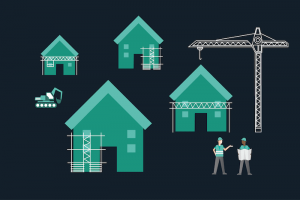2050 Net Zero targets require a totally new approach to construction. Buildings are responsible for 39% of global energy related carbon emissions. The entire supply chain must be focused on collaboration to tackle Climate Change. Procure Partnerships Framework’s Faye Dolan gives her perspective on the industry’s role and the future challenges.
2019: The Year we all Started Talking about Climate Change!
As we enter a new year and the familiar clichés of starting afresh and turning over new leaves are circling, it seems appropriate that our first blog of 2020 relates to climate change and how our industry needs to adapt and adjust to incorporate change.
2019 is being declared as the year when we ‘woke up’ to the climate emergency. School children joined the fight and went on strike from class, politicians were under increasing pressure to stop avoiding the issue, and activists up and down the country wreaked havoc to get our attention. And it seems the message has finally hit home. Across the construction industry we have seen professional institutions, including architects, civil engineers and building services engineers, unite to officially declare their allegiance with the climate change agenda and to commit to working together to implement change.
Climate change is set to be the hot topic on the construction industry’s agenda in 2020 and there is no denying the urgency for action. This blog will cover the Procure Partnership perspective on where we are currently at and where we need to be, in order to ensure a sustainable industry…
What does ‘Climate Emergency’ really mean for the construction industry?
Urban development contributes significantly to climate change; from the buildings where we live, to our hospitals, schools, workplaces and the infrastructure we use to travel, our built world produces a large proportion of greenhouse gas emissions worldwide. The science demonstrates that we are currently living ‘out of balance’. Throughout the ages, humans have existed, and in fact, thrived, whilst remaining in balance with the natural world. But, in the space of just one human lifetime, this has all changed. Our built environment now contributes almost 40% of all greenhouse gas emissions and our modern way of life is having dramatic effects on our planet and the ecosystems we depend upon.
The 2015 Paris agreement saw nations commit to limiting global warming to 2oC above pre-industrial levels as a way of limiting the impacts of global warming. However, an urgent warning from the Intergovernmental Panel on Climate Change (IPCC) in October 2018, declared that if the planet warmed by even 1.5oC there would be devastating consequences.
The IPCC report set in motion a string of climate shockwaves which shook 2019, drawing attention to the urgent need to avoid the catastrophic consequences of above 1.5oC warming. In order to cap temperature rises at 1.5oC, the IPCC reported that global CO2 emissions must drop 45% by 2030 and reach “net zero” by 2050. The UN says this translates to an annual drop of 7.6% by 2030 to stand any chance of reaching 1.5°C. In 2019, scientists expect that emissions will have instead risen by 0.6%…
The race is on. A total of 66 nations now have plans to be carbon-neutral by 2050. The cities of London and Paris declared official ecological and climate emergencies, and The European Parliament also declared a Climate Change Emergency at the end of 2019.
Changing the conversation
Declaring a Climate Emergency is a positive step, but in order to create an impact, the conversation needs to change at every level of our planning, design and construction process. In order to meet the needs of our society without stretching environmental and ecological boundaries, we require a radical shift in our behaviour. Construction professionals and experts need to lead the conversation and will play a fundamental role in raising awareness of climate and biodiversity emergencies and the urgent need for action amongst our clients and supply chains. It is our responsibility to share knowledge and research on an open basis and to work with local and national government to advise and guide. The aspiration to positively contribute to the climate change agenda must be a primary consideration of all new projects, and we must encourage our clients to also adopt this approach.
Perhaps the shockwaves of 2019 will provide both the confidence and the springboard needed for our industry to push climate change into the limelight and to wholly integrate sustainable philosophies into every element of the process?
The concept of ‘green buildings’ and reducing embodied carbon
Buildings are currently responsible for 39% of global energy related carbon emissions: 28% from operational emissions from the energy needed to heat, cool and power them, and the remaining 11% from materials and construction. The focus of collaboration across the whole supply chain must be to reduce carbon; the operational carbon which buildings emit after the construction phase and also the embodied carbon which is produced during the construction. Embodied carbon is made up from the entire construction lifecycle, including the production of the materials used in construction, the materials themselves, transport and machinery, right through to the building operation and the potential demolition of every piece of the development.
The World Green Building Council, a global network which is leading the transformation of the built environment to make it more sustainable, has issued a bold new vision that by 2030, all new buildings, infrastructure and renovations will have at least 40% less embodied carbon and significantly lower upfront carbon, and all new buildings will be net zero operational carbon. This is taken further in their aspirations for 2050, which will see all new and existing buildings, infrastructure and renovations achieving net zero embodied carbon and net zero operational carbon.
These ‘green buildings’ will, in their design, construction and operation, reduce or eliminate negative impacts on our climate and have the potential to create positive impacts through the preservation of natural resources and improved quality of life. According to The Word Green Building Council, any building can be a ‘green building’, including houses or residential properties, offices, schools, healthcare facilities or community buildings, provided it includes some of the following features:
· Efficient use of energy, water and other resources
· Use of renewable energy, such as solar energy
· Pollution and waste reduction measures, and the enabling of re-use and recycling
· Good indoor environmental air quality
· Use of materials that are non-toxic, ethical and sustainable
· Consideration of the environment in design, construction and operation
· Consideration of the quality of life of occupants in design, construction and operation
· A design that enables adaptation to a changing environment
What is the role of the contractor in the climate change agenda?
Whilst recognising the cultural change required in order to drive the environmental agenda, contractors are beginning to move away from the traditional (and sometimes limited) commitments from the past 10 years, which perhaps only paid lip service to the real issues. Leading contractors are beginning to embrace new, far reaching carbon reduction targets with a renewed confidence and enthusiasm.
The key to contractors delivering truly sustainable projects is to understand and to successfully measure carbon emitted from their projects. Data gathering is critical in meeting predetermined goals, as is a proper understanding of where the largest sources of carbon and waste are derived from.
A whole life carbon assessment should be undertaken and disclosed for all construction projects to drive carbon reductions. Whilst this is not a new concept and there is are various carbon measurement tools currently available, new research is emerging all the time which will provide new and more accurate ways to measure and reduce embodied carbon. One of these tools, which is currently being trailed, is the Carbon Infrastructure Transformation Tool (CITT), developed in a collaboration between the University of Edinburgh Business School and Costain, and funded by the Construction Climate Challenge (CCC).
The CITT solution provides a more detailed assessment of the carbon impact of a project at resource level compared to many existing tools. It has the potential to simplify the carbon assessment and intervention processes for all parties involved. The CITT will measure the embodied carbon emissions of infrastructure projects by integrating emissions data with outputs from estimators, planners and Building Information Modelling (BIM) technicians.
Tools such as this will be essential for design teams and contractors to accelerate the shift to low embodied carbon materials and to measure progress against goals, helping to focus minds and encourage collaboration.
Of course, one of the main challenges for contractors to overcome is the ability to communicate their sustainability objectives effectively to their teams and to train and upskill the workforce to deal with the new approaches and practices, and the technology they require. The concept of sustainable construction has moved fast in recent years, moving way beyond just reducing fuel bills or measuring site waste. The current 2050 Net Zero targets require a totally new approach and contractors must be at the heart of this revolution, developing innovative solutions.
Embedding this new culture is a significant challenge for many businesses, as is developing the right processes which make the ‘right’ thing to do, also the ‘easy’ thing to do. Maybe making a distinction between “traditional” buildings and “sustainable” buildings is becoming unhelpful, and instead of delivering pockets of excellence and flagship examples, we now need to move towards delivering a truly sustainable built environment – at scale.

Faye Dolan, an esteemed professional and Framework Director at Procure Partnerships, boasts a rich and diverse career spanning seven years in the construction industry. Faye’s journey within Procure Partnerships began in 2018 as a Key Account Manager, initially overseeing the North West region and later extending her purview to the entire North.



